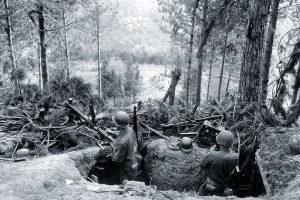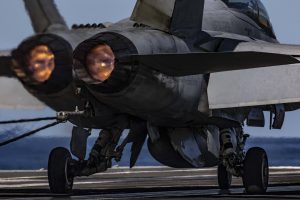West Point’s final field test offers ‘truly unique’ leadership lessons, say cadets

This week on Weapons & Warfare, host Ryan Robertson takes a deep dive into the Cadet Leadership Development Course (CLDT) at West Point. We’ll hear firsthand from cadets who have successfully completed this rigorous program, exploring how it shapes their journey as they prepare to graduate and become commissioned officers in the U.S. Army. Learn about the challenges they face, the skills they acquire and the impact of this transformative experience on their leadership development.
Also featured in this episode:
- The USMC conducts live fire training in the Caribbean.
- Anduril opens its Ghost Shark factory in Australia.
- Ukraine’s soldiers bring a low-tech solution to a high-tech problem.
- Weapon of the Week: We explore the U-Force military training system, a cutting-edge platform designed to enhance the proficiency of soldiers. The system includes an advanced simulator for the iconic Browning M2 heavy machine gun, allowing troops to practice their skills in a realistic yet safe environment.
You can subscribe to the Weapons & Warfare podcast on the platform of your choosing here.
Seniors at the U.S. Military Academy recently completed Cadet Leadership Development Training (CLDT), a two-week field exercise that marked the culmination of their tactical education before commissioning as officers in the U.S. Army.
CLDT placed cadets in realistic combat scenarios designed to test their leadership, decision-making and tactical skills under physical and mental stress. The program served as both a training opportunity and a final evaluation of their readiness to lead.
“It is the last real tactical development you are going to get before entering the Army,” one cadet said. “It is a reality check to know where you are physically and mentally, and it is also a good training exercise.”
Throughout the exercise, cadets assumed leadership roles in teams, squads and platoons. They navigated land, practiced rifle marksmanship, administered first aid and operated with limited sleep — all while managing the demands of leading others.
“CLDT is one of the first details where everything you do depends on someone else,” another cadet explained. “Your grade and performance rely on whether others are doing their job, maintaining security and giving their best effort. That is truly unique.”
The training emphasized both physical endurance and mental resilience. Cadets carried heavy gear across long distances and made rapid decisions in high-pressure environments.
“There is a lot of emphasis on the physical aspect — carrying weight and going long distances,” one participant said. “But it is the mental fortitude that stays with you. That is what builds our lethality: when you are physically degraded and still have to perform a mission with clarity and focus.”
Each scenario mirrored real-world threats, challenging cadets to adapt and overcome obstacles. Many described the experience as transformative.
“Everyone here has been challenged in ways we never have before,” one cadet said. “We had to find mechanisms and rely on others to get through it. Those shared experiences built bonds and morale.”
CLDT represented the final step in a 47-month journey at West Point, where cadets progressed from taking the oath of allegiance as freshmen to graduating as commissioned officers.
“West Point put us through trials and tribulations that made us better people and better leaders,” one cadet reflected. “This experience taught me that I am capable of whatever I put my mind to.”
The U.S. Military Academy designed CLDT to prepare cadets for the realities of military leadership, ensuring they enter the Army with the skills, confidence and resilience required to lead in combat and beyond.
Weapon of the Week: U-Force enhances military training
Earlier this fall, W&W host Ryan Robertson visited “Defense Valley Tech 2025” in Lviv, Ukraine, where the cutting edge of military innovation was on display. Amidst the exhibits showcasing next-generation defense systems and autonomous technologies, Robertson had an opportunity to experience a new training method being adopted by Ukrainian forces.

Stepping onto the virtual range, Robertson donned a pair of VR goggles to engage in a simulated target practice session. The training focused on anti-drone warfare, utilizing a virtual M2 Browning heavy machine gun. This immersive simulation allows soldiers to hone their skills in quickly identifying and neutralizing aerial threats, a vital necessity on the modern battlefield.
The post West Point’s final field test offers ‘truly unique’ leadership lessons, say cadets appeared first on Straight Arrow News.





